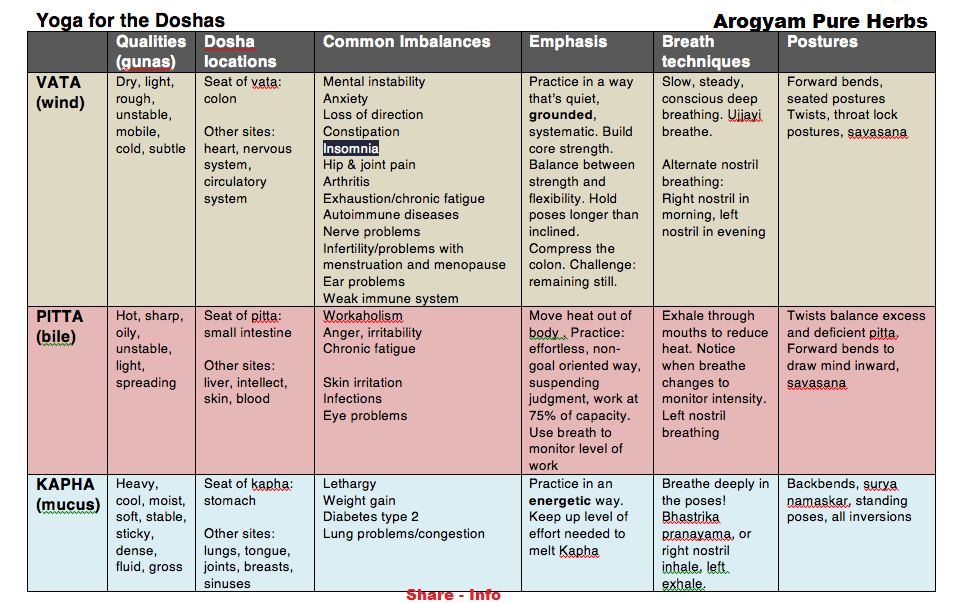- Your cart is empty
- Continue Shopping
Essential Oils and Tridosha Yoga — A Perfect Match of Medicines and Practice according To Your Dosha

Yoga and essential oils are a perfect match. There are so many ways to support a yoga practice using essential oils. Essential oils can be used for a very wide range of emotional and physical wellness applications and can be used a single oil at a time or in complex blends depending on user experience and desired benefit. They harmonize perfectly with a yoga practice as well as other accompanying healing modalities such as chakra balancing and ayurvedic dosha balancing.
Essential oils are usually administered by one of three methods: diffused aromatically, applied topically, or taken internally as dietary supplements.
Aromatic Uses
Our sense of smell influences many physiological pathways including the stimulation of hormones and other metabolic processes. Aromatherapy is founded on the body’s predictable response to specific olfactory stimuli. Essential oils are widely used in aromatherapy applications. Certain essential oils, when diffused in the air, can be very stimulating while others can be calming and soothing. Beyond emotional benefits, diffusing essential oils can purify air of unwanted odors and some airborne pathogens. Low or no-heat essential oil diffusers are recommended as they do not change the chemical structure of the oil being diffused. Essential oils can also be used as cleansing and purifying additives to laundry and surface cleaners throughout the home.
Quick Yoga Tip: Try starting a morning practice by placing Wild Orange Essential oil on your wrists. Inhale deeply. As you work though your sun salutations, you will be able to smell the energizing and uplifting aroma of Wild Orange with each pass of your arms.
Topical Uses
Due to their natural molecular composition, essential oils are easily absorbed by the skin and can be safely applied topically. Application of essential oils can have immediate, localized benefit to the target area of application. They have restorative and calming properties and can be used effectively with massage and beauty therapy. They are also natural disinfectants. The chemical structure of essential oils also allows them to be absorbed into the bloodstream via the skin for internal benefit throughout the body.
Some oils should be diluted with a carrier oil such as fractionated coconut oil, grape seed, or olive oil. Many can be applied NEAT to the skin, meaning applied without a carrier. They are great for full body massage or spot treatments of problem areas.
If using multiple oils, it’s better to layer them one at a time rather than spreading them all at once. Also, essential oils are most effective in small quantities repeated often.
Quick Yoga Tip: Try rubbing Breathe Blend or Peppermint onto your chest and over lungs before a workout to open airways and prepare your body for effective oxygenation and to help you focus your practice on breathing.
Internal Uses
Essential oils can also be used as dietary supplements supporting a variety of healthy conditions. Some essential oils have powerful antioxidant properties while others help support healthy inflammatory response in cells. Many essential oils are generally regarded as being safe for dietary use, but some oils should not be taken internally. Do not use any essential oil product internally that does not have the appropriate dietary supplement facts on its label.
Essential oils can also be used in cooking, though you will need significantly less of doTERRA CPTG essential oils in your recipes than commercial, food grade flavor oils. For example, one drop of peppermint oil is equivalent to 28 bags of peppermint tea.
Quick Yoga Tip: Try adding Lemon oil to your water to help eliminate toxins from your body.
——————————————————————–
Using essential oils can be both profoundly simple and life changing at the same time. Working with someone who has used essential oils before will help first-time users have a more beneficial and enjoyable experience.
Be sure to use only 100% pure therapeutic-grade essential oils and follow all label warnings and instructions.
Essential oils should not be used in the eyes, inside the ear canal, or in open wounds. If redness or irritation occurs when using essential oils topically, simply apply any vegetable oils such as fractionated coconut oil or olive oil to the affected area. Consult your physician before using essential oils if you are pregnant or under a doctor’s care.









